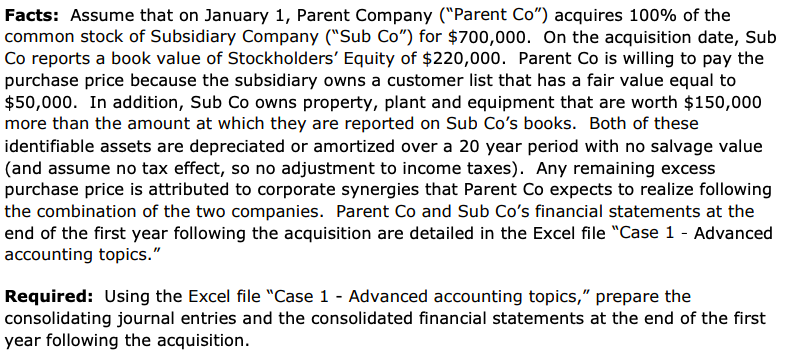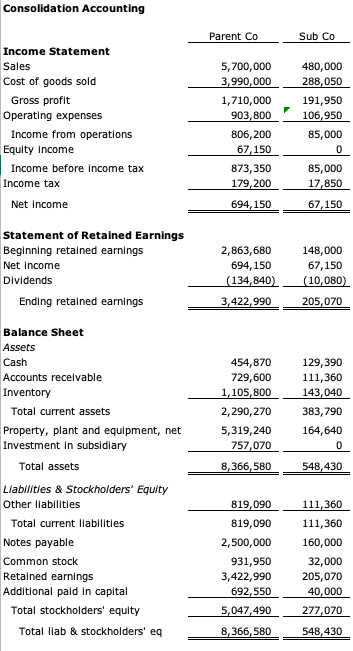

Facts: Assume that on January 1, Parent Company ("Parent Co") acquires 100% of the common stock of Subsidiary Company ("Sub Co") for $700,000. On the acquisition date, Sub Co reports a book value of Stockholders' Equity of $220,000. Parent Co is willing to pay the purchase price because the subsidiary owns a customer list that has a fair value equal to $50,000. In addition, Sub Co owns property, plant and equipment that are worth $150,000 more than the amount at which they are reported on Sub Co's books. Both of these identifiable assets are depreciated or amortized over a 20 year period with no salvage value (and assume no tax effect, so no adjustment to income taxes). Any remaining excess purchase price is attributed to corporate synergies that Parent Co expects to realize following the combination of the two companies. Parent Co and Sub Co's financial statements at the end of the first year following the acquisition are detailed in the Excel file "Case 1 - Advanced accounting topics." Required: Using the Excel file "Case 1 - Advanced accounting topics," prepare the consolidating journal entries and the consolidated financial statements at the end of the first year following the acquisition. Consolidation Accounting Parent Co Sub Co Income Statement Sales Cost of goods sold Gross profit Operating expenses Income from operations Equity Income Income before Income tax Income tax Net Income 5,700,000 3,990,000 1,710,000 903,800 806, 200 67,150 873,350 179,200 694, 150 480,000 288,050 191,950 106,950 85,000 0 85,000 17,850 67,150 Statement of Retained Earnings Beginning retained earnings Net Income Dividends Ending retained earnings 2,863, 680 694,150 (134,840) 3,422,990 148,000 67,150 (10,080) 205,070 454,870 729,600 1,105,800 2,290, 270 5,319,240 757,070 8,366,580 129,390 111,360 143,040 383,790 164,640 0 548,430 Balance Sheet Assets Cash Accounts receivable Inventory Total current assets Property, plant and equipment, net Investment in subsidiary Total assets Liabilities & Stockholders' Equity Other liabilities Total current liabilities Notes payable Common stock Retained earnings Additional paid in capital Total stockholders' equity Total llab & stockholders' eq 819,090 819,090 2,500,000 931,950 3,422,990 692,550 5,047,490 8,366,580 111,360 111,360 160,000 32,000 205,070 40,000 277,070 548, 430








